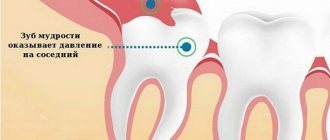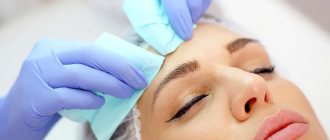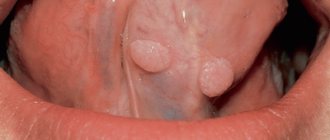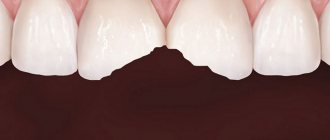A snow-white smile today is considered a mandatory attribute of beautiful appearance. Therefore, when black spots appear on the teeth, there is a desire to get rid of them as soon as possible. But first you need to understand the reason for the appearance of blackheads. Why the enamel darkens, whether it could be caries, we will tell you in the article.
In this article
- Is a black dot on a tooth a caries?
- What is black caries?
- Spots on teeth due to fluorosis
- What to do if large or small spots appear on your teeth?
- How to treat caries in the form of spots on teeth?
- Prevention of caries and dark spots on teeth
The process of formation of dark plaque on teeth -
As we said above, dark plaque on teeth is formed due to various pigments that are deposited on the surface of the teeth. But to be completely precise, it is thanks to chromophores (these are compounds in pigments that determine their color). Chromophores can be of organic and inorganic origin. For example, organic chromophores include the so-called polyphenolic compounds, which include “tannins”, “furfural”, etc. These compounds can be found in coffee, tea, wine and fruits.
Tobacco smoke (polyphenols, etc.) also contains a large number of dark-colored pigments of organic origin. As for inorganic chromophores, these include metal ions - primarily Fe 2+ and Fe 3+ (divalent and trivalent iron), Cu 2+ (divalent copper), as well as Mn 2+ (divalent iron). valence manganese). And I think - everyone now understands that the formation of pigmented plaque on teeth occurs due to the deposition of organic and inorganic chromophores on the surface of the teeth. A particularly interesting process will be the deposition of metal salts on the teeth of children and adults, which we will discuss in detail below.
Important: dark plaque on teeth forms much more slowly if the surface of the teeth is clean and does not have a layer of soft microbial plaque or hard tartar. But, if there is soft microbial plaque on the teeth that has not been properly removed (during oral hygiene), or there is already a tightly attached layer of partially mineralized plaque, then in this case the pigments are integrated into their structure much faster.
Those. to the bacterial film on the surface of the teeth, as well as to a rough surface (for example, fillings) - pigments will “stick” much faster than to a completely clean tooth surface. The same applies to tartar, which is dental plaque mineralized by calcium salts contained in saliva (primarily calcium phosphate). And chromophores, i.e. pigments - they can integrate perfectly even into the crystal lattice of calcium phosphate, which, together with bacteria, makes up tartar.
Prevention of caries and dark spots on teeth
In most cases, darkening of the enamel can be prevented by following simple preventive measures.
- Brush your teeth regularly and correctly.
Clean the surface of your teeth, gums, and tongue from plaque at least twice a day using a therapeutic and prophylactic paste that is appropriate for the age and condition of your teeth. Do not use fluoride toothpaste without a doctor's recommendation to avoid fluorosis. To clean brace systems, purchase special brushes that will ensure high-quality removal of food debris and other contaminants in the areas where the braces adhere to the teeth. Use dental floss, irrigator, and mouth rinses to clean all hard-to-reach areas.
- For preventative purposes, visit the dentist twice a year.
Any dental problems, including dark spots, can be treated much easier and faster if they are detected at an early stage. Teeth affected by caries in the form of a small point are in some cases treated using non-invasive methods - without drilling or filling.
- Professional cleaning twice a year.
Once every six months, carry out ultrasonic or laser teeth cleaning to remove complex deposits.
- Rejection of bad habits.
If possible, reduce the consumption of coffee, tea, Coca-Cola, and stop smoking. This will have a beneficial effect on the appearance and condition of your teeth.
Dark plaque on teeth from smoking, tea and coffee -
Yellow or brown plaque on teeth can most often be found in patients who smoke or drink strong coffee or tea. Below we will once again present 2 photographs in which we ask you to pay attention to the following. Both patients have plaque on their teeth (especially a lot of soft microbial plaque). We have already said above that pigments hardly adhere to clean tooth enamel, but very quickly attach to the layer of microbial plaque.
Pigment + bacterial plaque –
But if with stains from tea and coffee everything is quite simple, and they can be attributed simply to superficial pollution, then with smoking things are more complicated. On the one hand, some of the pigments contained in tobacco tar will indeed remain only on the surface of the tooth enamel, and in the future this pigment plaque can be removed without problems. But on the other hand, experienced smokers may experience a change in the physiological color of the enamel and even dentin, which is associated with prolonged penetration of the resin into the depths of the hard tissues of the tooth (this occurs through many micro-cracks on the surface of the enamel). And such pigmentation cannot be changed by professional teeth cleaning, and chemical whitening will be required.
But yellow plaque on teeth can form not only among lovers of tobacco, strong tea or coffee. Pay attention to the photo of the lower teeth below. This patient does not smoke, does not abuse coffee or tea, but in this patient, in the area of the necks of the teeth, a layer of partially mineralized dental plaque is clearly visible, which is already tightly attached to the tooth enamel and can no longer be cleaned off with a regular toothbrush. Those. The problem here, again, is not related to excessive consumption of coffee or tea, but, first of all, to insufficient oral hygiene. As a result of this, the completely soft microbial plaque that has not been removed begins to mineralize and at the same time turns a little yellow.
Partially mineralized dental plaque –
Important: drinks and food products that contain a large amount of pigments - dark-colored carbonated drinks, beets, wine, tea or coffee, spices, berries and some fruits (24stoma.ru). If the tooth enamel is not covered with a layer of microbial plaque, then such products can only temporarily change the color of the tooth enamel (for example, many people notice that immediately after drinking wine their teeth turn blue for a short time). But in the presence of dental plaque, pigments penetrate into the structure of the latter, remaining in it for a long time.
Other causes of darkening of teeth -
Some ingredients in oral care products can stain your teeth. First of all, we are talking about such a common antiseptic as chlorhexidine, which is included in many toothpastes and mouth rinses. The same effect can be caused by the antiseptic benzalkonium chloride, which can be included not only in some mouth rinses, but also in some dental gels (an example is Kamistad gel).
Long-term use of rinses and toothpastes containing essential oils can also lead to darkening of your teeth, because the latter are also polyphenolic compounds (eg Listerine mouthwash). But here it should be noted that black plaque on teeth as a result of the use of antiseptics and essential oils does not appear in all patients. The fact is that darkening occurs only on those surfaces of the teeth on which there is a layer of microbial plaque. And it is possible that while this coating was light, you simply did not notice it. But in any case, such darkening will be reversible.
Dark plaque after using chlorhexidine -
Another common ingredient in hygiene products that can lead to darkening of teeth is stannous fluoride (SnF2), which is included in some toothpastes as an anti-caries component. There is a scientific paper about this at the link above. The fact is that pigments (chromophores) can also be formed by chemical processes of initially colorless compounds. In addition, stannous fluoride can react with volatile sulfur compounds produced by oral bacteria to form tin sulfide (SnS2). This can cause plaque-covered tooth surfaces or demineralized areas of enamel to turn yellowish.
But! Dark plaque on teeth can occur even with good oral hygiene, and even if you do not smoke or drink strong tea or coffee. This formation mechanism is associated with the vital activity of chromogenic bacteria in the oral cavity, which primarily includes actinomycetes. Most often, the formation of such plaque occurs in children, but adults are no exception (see photo below).
Black plaque produced by chromogenic bacteria -
What is black caries?
There is no such term as black caries in dentistry. But among ordinary people this is the name given to the stage of the carious process at which the teeth darken. How does this happen?
“Black caries” may be at the initial stage. In this case, first white and then black dots form on the surface of the enamel - areas of demineralization. In these places, the enamel is thinned and vulnerable to the damaging effects of acid. If you do not pay attention to the blackheads in time and do not treat them, then the caries will go deeper and spread to the dentin.
Sometimes “black caries” is a carious lesion in which a hole has already formed in the tooth. Bacteria produce organic acids and gases, which not only destroy the structure of tissues, but also stain them. With caries, black spots can even show through tooth enamel.
Black plaque on a child’s teeth –
As we said above, the mechanism of deposition of insoluble metal salts on teeth will work not only in children, but also in some adults. The fact is that in the oral cavity there are bacteria called actinomycetes. They are anaerobic bacteria and are often called chromogenic bacteria. It is these bacteria that are responsible for the appearance of black or tightly attached plaque, located circularly in the area of the necks of the teeth (Fig. 10-12). Sometimes such plaque may have a brown or greenish tint.
Black plaque in a child -
According to various statistics, the formation of dark plaque occurs in 1 to 20% of all children, and the process itself occurs as follows... Actinomycetes, in the course of their life activity, release hydrogen sulfite, which enters into a chemical reaction with iron compounds contained in saliva. As a result, an insoluble form of iron is formed (with impurities of calcium and phosphorus), which is deposited on the teeth in the form of a black plaque. Moreover, this happens even in patients with high-quality regular oral hygiene.
Scientific studies have shown that the deposition of black plaque in the form of insoluble iron salts is associated with 2 main factors. Firstly, we are talking about the species composition of the microflora of the oral cavity, i.e. The higher the content of actinomycetes in the oral cavity, the higher the risk of black plaque formation. Thus, one of the scientific studies showed that in children aged 6-12 years with black spots, actinomycetes were sown in 70% of cases, and in children without black spots - only in 20% of cases. And this shows an obvious dependence.
In addition to actinomycetes, bacteria of the genus Prevotella, for example, P.gingivalis and P.intermedia, can also lead to the deposition of insoluble iron salts. But they show such activity only if a child or adult has concomitant gum inflammation, manifested by bleeding. Those. These bacteria extract iron from red blood cells that enter the mouth during gum disease, turning it into black plaque. Thus, the presence of gingivitis in the patient is another risk factor.
The connection between black plaque and drinking water –
Scientific studies show that drinking unfiltered tap water, as well as water purified by osmosis, increases the risk of deposition of insoluble iron salts in the form of black plaque by 13 times (you can read the clinical study at this link). How to remove such plaque - read at the very end of the article.
Why do stains appear on teeth: the main reasons
The initial form of caries can be provoked by various factors, but most often this happens due to the formation of an acid-base imbalance in the oral cavity. A large number of harmful microorganisms constantly live in the mouth, which actively participate in the process of food decomposition. Food particles tend to remain between the teeth and on their surface, which leads to the destruction of tooth enamel.
Other reasons leading to the destruction of the structure of the enamel layer on the teeth include:
- incomplete or poor oral hygiene. After some time, failure to comply with hygiene rules leads to the appearance of white plaque on the teeth, which acts as an excellent environment for the accumulation of pathogenic bacteria. As a result, microorganisms produce harmful acids, which negatively affects the condition of tooth enamel. This process can be prevented by regular oral hygiene procedures. If, nevertheless, destruction of the enamel is observed, then treatment of caries at the spot stage will help prevent complications;
- hereditary predisposition. Even at the moment of conception and during intrauterine development, the structure and strength of tooth enamel is laid in the baby. When the mother’s body during this period lacks fluoride, calcium, vital vitamins and minerals, the risks that the child’s teeth will be excessively fragile and prone to the formation of carious processes are maximum;
- poor nutrition. Tooth enamel will be hard and durable if the daily diet contains foods high in calcium, fluorine and phosphorus (fish, cheese, cottage cheese, nuts, milk). But foods containing a large amount of carbohydrates (sweets, baked goods) must be kept to a minimum. This will protect the enamel from premature destruction;
- changes in the composition of saliva and its increased viscosity. Along with the fact that saliva is involved in the process of softening the food consumed, it also cleanses the surface of the teeth from food debris. When, due to changes in the structure of saliva, its acidity increases, a constant destructive effect on the teeth is formed. This process leads to the development of carious pathologies.
Often the initial form of caries appears in the area of the neck of the tooth, which is difficult to clean with a toothbrush. Regular examination of the condition of the teeth by a dentist and, if necessary, professional cleaning will help prevent the development of carious processes.
How to remove black plaque on teeth -
If you only have a not too pronounced dark plaque on your teeth (in the absence of tartar or a thick layer of pigmented plaque), its amount can be reduced using an Oral-b electric brush and a special toothpaste with increased abrasiveness. We'll cover this method below, but keep in mind that this will only work on a thin layer of plaque.
How to remove plaque on teeth if a thick layer of plaque has formed or there is already tartar - in this case, you should immediately contact your dentist for professional teeth cleaning. Professional cleaning will completely remove all external contaminants from your teeth, but if you are an experienced smoker and pigmentation of the hard tooth tissues themselves (enamel and dentin) has already occurred, then chemical bleaching may also be required.
What to do if large or small spots appear on your teeth?
Any changes in the color or structure of tooth enamel are a reason to be wary and seek advice from a dentist. Only a doctor, after diagnosis, will be able to accurately answer the question: is a blackhead a symptom of caries? Or the darkening occurred for another reason.
If a stain on the front teeth occurs as a result of a bruise, the dentist will remove the affected tissue, process and fill the canals, and, if necessary, recommend installing veneers or endo-whitening (lightening the tooth from the inside).
If the cause of dark spots is poor hygiene or poor plaque removal, professional cleaning using ultrasound or laser will help solve the problem. These methods are good at removing plaque and tartar from the enamel surface and returning the teeth to their natural shade.
If food coloring is the cause of teeth staining, professional hygiene combined with a subsequent whitening procedure can help.
Unfortunately, dark spots on teeth are caries in the vast majority of cases, and the carious process at any stage requires immediate treatment.
Removing dental plaque at the dentist -
Depending on the amount of plaque and tartar, as well as the equipment of the dental office, the dentist can use the following methods or a combination of them:
- ultrasonic cleaning + conventional mechanical polishing (carried out using a polishing brush and paste),
- ultrasonic cleaning + Air-Flow,
- Air-Flow only.
a) Cleaning dental plaque using Air Flow –
The Air-Flow method is something like sandblasting. From a special tip under high pressure, a water-air mixture with particles of an abrasive-polishing substance is supplied to the tooth surface. This method works great if your layer of pigmented plaque is not too thick and there are no massive hard dental deposits. But if they do exist, then the dentist will first remove the massive deposits with ultrasound and, using Air-flow, polish your teeth, removing all the smallest irregularities and plaque residues.
How to get rid of plaque using Air-flow –
b) Removal of dental plaque using ultrasound –
Ultrasound cleaning of plaque is the most common and most versatile method. Its advantage is that with the help of ultrasonic cleaning devices (scalers) you can remove pigmented plaque of any severity, as well as the most massive hard dental deposits. The cost of the procedure averages from 150 to 200 rubles per 1 tooth, but there are clinics where this service can cost even 400-500 rubles (per 1 tooth).
A nozzle is inserted into the tip of the ultrasonic scaler, the tip of which oscillates at ultrasonic frequency during the procedure, and during the oscillation process water is supplied generously to the tip of the nozzle. As a result of mechanical contact of the nozzle with dental plaque, the attachment of the latter to the tooth is destroyed. The cavitation mechanism also works in parallel. It lies in the fact that the propagation of ultrasonic waves in an aqueous environment leads to the formation of many air bubbles, which burst with the occurrence of hydrodynamic impacts (this leads to cleansing of the tooth surface).
Removing plaque using ultrasound (video) –
After ultrasonic cleaning, tiny particles of plaque (irregularities) always remain on the surface, which must be removed. This can be done either using Air-flow, or using traditional teeth polishing using a rotating polishing brush with bristles and a special polishing paste. If polishing is not done, the tooth surface will remain rough, which will lead to the rapid adhesion of new portions of microbial and pigmented plaque to the teeth.
Stages of caries spots
Dentists distinguish several stages of damage to one or more teeth by caries. Each stage is characterized by certain features, differences and symptoms.
Caries in the white spot stage
During the initial stage of caries, a person does not experience any discomfort and does not feel pain. The pathogenic process can be identified only by the white spots formed on the surface of the teeth. Although at first glance the tooth seems absolutely healthy, when stains appear in it, the process of destruction of structural tissues already occurs.
The spots that appear on the enamel in the initial stage have a whitish tint and are small in size, so upon visual inspection they are practically invisible. Only a professional specialist is able to identify the onset of pathogenic destruction of tooth enamel and promptly treat caries in the stain stage.
If you ignore treatment, then over time the light spot fades, tooth enamel loses its natural shine, becomes fragile and loose, and the carious process progresses more and more.
Important! If you identify the development of the initial form of caries, which manifests itself as microscopic specks, then you can avoid serious dental treatment. Therefore, every person should visit the dentist at least 2 times a year for a preventive examination of the oral cavity and, in particular, the condition of the teeth.
Black spot on teeth
If you ignore the appearance of white spots, then caries gradually passes into the next stage of a dark spot. This form is more serious and dangerous in comparison with the previous one.
Demineralized tissues grow very quickly, the white spots become darker and more visible. The white shade turns into brown or brown due to pathogenic bacteria entering the porous structure of the enamel.
Pathogenic microorganisms increasingly destroy the tooth surface and the disease moves into the next stage - superficial caries, the treatment of which is longer and more complex.
How to remove plaque from teeth at home -
You can remove plaque from your teeth at home using a combination: an Oral-b electric brush + a special teeth polisher.
As the latter, you can use, for example, PRESIDENT White Plus toothpaste, which has an abrasiveness of RDA 200. But the best option is to buy a special dental polishing paste that the dentist uses. The best option for such polishing pastes is Detartrine or Detartrine Z (the latter is better, but more expensive). Oral-b toothbrush and Detartrine series toothpastes:
You can use the Oral-b electric toothbrush every day, and in fact, these brushes are made exactly like a dentist's tool for polishing teeth from plaque. But the special tooth polishing pastes mentioned above are not intended for daily use, but only for periodic processing. Such pastes are capable (even without the use of ultrasonic cleaning) of removing not only moderate pigmentation plaque, but even small tartar.
But still, it would be optimal to first undergo professional oral hygiene at the dentist, and use our recommendations as “regular maintenance therapy.” In addition, it should be taken into account that the home method of removing plaque mentioned above has special requirements for the process of carrying out this procedure, which you can read in the article at the link below.
→ Removing stone and plaque
Common reasons
Darkening of teeth can look different:
- If the discoloration is caused by plaque that is not properly removed, the color of the dentition appears uneven, darker at the base and lighter towards the edges; Possible causes are abuse of coffee and tea (strongly brewed drinks have a powerful coloring effect) and smoking. It is very difficult for tea, coffee and nicotine lovers to maintain a snow-white smile; they practically have to choose between beautiful teeth and established habits.
- If one or more teeth have a pronounced color difference, we have to talk about poor-quality canal treatment or the development of secondary caries (after removal of the nerve, the darkening of the tooth is explained by the lack of nutrition and is natural; a dark rim around the filling is a signal for its immediate replacement due to a violation of the tightness ). A tooth can also be darkened by trauma that causes nerve death or internal bleeding; whiteness can only be restored through careful treatment of the canals, sometimes with intracanal bleaching.
Black plaque is not only a death sentence for a smile, but also a possible cause of caries. Only regular visits to the dentist will help you avoid troubles and keep your teeth healthy and white.
Black plaque on a child’s teeth: treatment
Both pigmented microbial plaque and chromogenic staining of teeth due to the activity of actinomycetes bacteria are removed equally in both children and adults, but there are nuances depending on age. For example, Air-flow can be used no earlier than from 12-15 years of age (at the discretion of a specialist), ultrasonic cleaning can be used from 14 years of age. Therefore, in younger children, removal of dark plaque is carried out only with the help of a polishing brush and paste.
Removing dark plaque from a child (before and after photos) –
The main problem with removing pigment plaque caused by chromogenic staining (deposits of insoluble iron salts) is that usually the black plaque returns within 2-3 weeks. Therefore, you don’t really go to the dentist. And in order to prevent the reappearance of black plaque as much as possible, you need to follow the recommendations from the list below.
Prevention of chromogenic staining –
- solve the problem with drinking water (we already said above that drinking ordinary tap water, as well as water purified by an osmotic filter, increases the risk of stains by 13 times),
- stop taking chewable forms of vitamins,
- if you have bleeding gums, you need to see a dentist and have gingivitis treated,
- if you use pastes with stannous fluoride, switch to pastes with sodium fluoride or amino fluoride,
- use toothpastes that contain pyrophosphates, sodium citrate, polyaspartate, as well as polydone and bromelain (all these components prevent pigments from attaching to tooth enamel),
- use toothpastes with lactoferrin (this glycoprotein has the ability to bind 2 trivalent iron ions per 1 molecule),
- Buy your child an Oral-B electric toothbrush (from 3 years of age).
All this will reduce the risk of black plaque deposits, and thanks to an electric toothbrush, you can also polish your child’s teeth yourself. Here it is necessary to clarify that many models of Oral-B electric toothbrushes are for adults - in some modes they can also be used by children from 4 years old, but under the supervision of adults. By the way, you can read about how lactoferrin prevents the formation of black plaque from insoluble iron salts in an English-language study at this link.
Why do children's teeth turn black?
While many explanations can be found for the darkening of tooth enamel in adults, black teeth in a child cause bewilderment and confusion among parents. In fact, a child’s teeth can darken even with careful hygiene and in the absence of chronic diseases.
There are several reasons for the problem, the main one is improper nutrition with the amount of sweets in the diet: microbes, like people, love sweets, the effect of sweet food on tooth enamel is negative, associated with the appearance of a dense microbial biofilm. Other common reasons:
- genetic predisposition
- calcium deficiency
- dysbacteriosis
- early caries
If you notice dark gingival stripes on your child’s teeth, do not ignore them: the appearance of the so-called Priestley’s plaque is one of the consequences of the development of the digestive system, which resolves itself with age, but it is better to clarify the diagnosis with a dentist. Dark spots and dots on the baby’s teeth should also cause concern: contrary to the popular belief that baby teeth should not be treated, in the absence of adequate treatment, permanent ones that grow to replace them are often damaged.
Black teeth in a child are an alarming signal that requires an immediate preventive examination by a dentist, since all pathologies develop rapidly in childhood.
Why does the enamel color change?
Blackheads occur for many reasons, of which dentists identify the main ones:
- Presence of plaque if not cleaned regularly with a toothbrush.
- Hereditary factor.
- The presence of sealed teeth treated with metal fillings.
- Smoking and alcohol abuse.
- Long-term wearing of braces.
- Poor cleaning of dental canals due to caries.
- Erasure of enamel.
- Use of tetracycline antibiotics for treatment.
Abuse of chlorhexidine-based mouthwashes
Teeth inevitably become covered with black plaque if you rinse your mouth with Chlorhexidine or rinses that contain this medicinal substance for a long time. Chlorhexidine fights bacteria and viruses well, helps eliminate the inflammatory process in the mucous membrane, helps damaged tissues recover faster, reduces bleeding gums, but it cannot be used for longer than 10–14 days in a row.
The enamel can also darken due to the abuse of rinses that contain benzalkonium chloride, as well as essential oils. Products with such components are not suitable for daily use. They are used only in courses and according to indications, for example, in complex therapy for the treatment of gingivitis or periodontitis.
What is Priestley's plaque?
This plaque looks like black specks or lines of specks along the neck of the tooth. Plaque is quite tightly attached to the surface of the tooth and is difficult to clean with a regular brush.
It is usually found in children, although it can occur in adults.
There is no evidence that this plaque is somehow related to the pathology of the gastrointestinal tract.
This plaque is called bacterial, and for good reason: if you look at the plaque, it turns out that these are plaques created by a community of special bacteria, with a predominance of Actinomyces (Actinomyces naeslundii).
Black plaques have higher calcium and phosphate contents than uncolored plaques.
The black color is the result of the interaction of iron and copper ions (they are in our saliva) and hydrogen sulfide, which is released by plaque bacteria - the same actinomycetes.











